
Article: H. FRANZ (GERMANY)
Team Trainer for Ship’s Hospital Teams
At the Institute of Maritime Medicine of the German Navy, sea-going medical teams and the medical support units of the Naval Special Forces are offered a team training course when preparing for deployment. As the course is held in a sick bay model, participants have the unique chance to familiarize with working in the limited spaces characteristic of the situation at sea.
Introduction
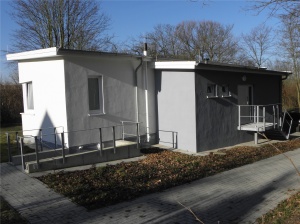
As it seems clear today that simulation methods provide the highest learning affect in military medical training the Institute of Maritime Medicine of the German Navy (Fig 1 ) has developed a simulation based training course for sea-going medical teams and the medical support units of the Naval Special Forces (Spezielle Einsatzkräfte Marine, SEKM) when preparing for deployment.
The training programme is designed to ensuring that participants have a good command of emergency medical procedures and practice working as part of a team. They learn basic skills in airways management, the provision of first aid to patients with respiratory/cardiovascular disorders and resuscitation techniques. As the course is held in a life size model sick bay, participants have the unique chance to familiarize with working in the limited spaces characteristic of the situation at sea. Another of the central features of the training course is that participants are familiarised with the crew resource management concept. The communication between team members and their interaction while dealing with the ‘patient’ is documented using a video camera and the results are discussed in detail in a subsequent debriefing.
Course design:
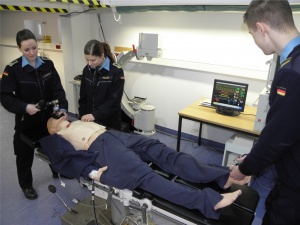
The course was first set up in December 2005 as a two-day training course. It was designed specifically for on-board naval medical teams consisting of a medical officer with a qualification in emergency medicine, a warrant officer trained as an emergency medical assistant, a further NCO and one or two naval medics. On-board medical teams and the medical support units of the Naval Special Forces accompany crews during sea-going missions and thus do not have the opportunity to rapidly transfer casualties to hospitals where they can receive the best possible level of care, as is the case in the land-based metropolitan environment. With this in view, it was considered necessary to provide on-board medical teams and the SEKM medical personnel with specially targeted training to ensure that they would work as efficiently as possible in the event of an emergency. In addition, during the course they can practise working as part of the team and are coached to identify and eliminate any potential weak points in the communication and interaction between the team members.
The crew resource management (CRM) concept provides for training designed to enhance specific ‘non-technical’ skills. Improvement of communication is one of the core needs here, and practicing communication skills is an element that is a recurring facet of the training course. The CRM concept is intended to increase awareness that it is not just technical proficiency, but also the inter-human factor that plays a significant role in all situations. The understanding of the procedures and processes of patient care is also extended, so that all the mental resources of the on-board team can be brought to bear. Team skills are improved and the risk of failure due to human error reduced. It has been shown that the main causes of human error are lack of communication, insufficiently clearly defined leadership roles and the inability to make decisions.
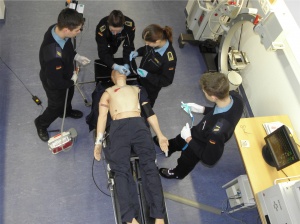
The training course employs a SimMan (Laerdal) adult patient simulator (Fig 2). The manikins are controlled by a computer unit that generates simulated physiological vital signs for the respiratory and cardiovascular systems. The sick bay course trainers have been instructed in the operation of the dummy by Laerdal. In addition, they have also been taught how to design various appropriate scenarios and ensure that the training sessions conform to European standards at the Patient Safety and Simulation Centre (TÜPASS) of the University of Tübingen. Using two cameras, the activities of training course participants are recorded from two different perspectives for subsequent analysis. The seminar room can accommodate a maximum of two teams or up to eight participants.
Course procedures:
Each course session is intended to progressively help the participants find out what their psychological and emotional limits are.
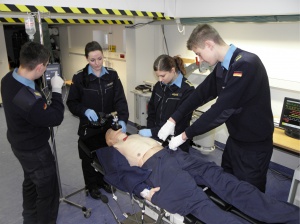
They first attend a technical training/refresher session in the use of the emergency life support equipment that is in standard use by the German Armed Forces. These include the Propag EL patient monitor, the Medumat Life Base III ventilator, the Zoll M defibrillator and perfusors. Particular attention is paid to device fault analysis and systematic identification of causes of equipment failure. They are then shown in detail how to work with and use the manikin so that they are able to act as naturally as possible during the training sessions.
They also practice all the technical skills that would be taught, for example, in an ATLS (Advanced Trauma Life Support) course. Participants are required to master the following procedures:
- Securing airways passages – using masks and tubes (Fig 3). They also need to be able to perform emergency cricothyroidopunction or even cricothyroidotomy in case the patient has suffered significant trauma to the face or jaw. A bovine larynx is used for practice purposes.
- Finding an access for the administration of fluids (Fig 4): the intraosseous technique for giving infusions and medications is practiced in case it is impossible to establish a peripheral venous access. One option is the Bone Injection Gun, which is now in standard use by the Israeli armed forces as it is associated with a low rate of complications and infections even if left in place for longer periods. Participants are also shown the use of the F.A.S.T 1 system.
- Participants then practise decompression of a tension pneumothorax using a porcine carcass. The medical officers will already have gained experience of dealing with real cases in hospital during their emergency medical training.
- Anaesthesia: participants are next given the appropriate information and trained in the practical skills in the areas of physiology, pathophysiology and pharmacology needed to initiate, induce and maintain anaesthesia for the transport of a patient. Various aspects of mono-anaesthesia and combined anaesthesia are discussed. In the German armed forces, it is now the standard procedure to use a relative simple form of combined anaesthesia (diazepam/ketamine). The acquired theoretical knowledge is subsequently put to practical use with the aid of the patient simulator.
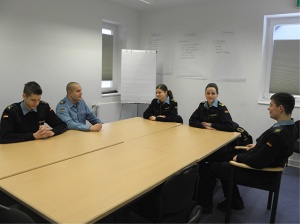
Over the two days, two teams alternate in dealing with a total of eight simulated cases, beginning with anaphylactic shock and finishing with a case of severe polytrauma with a shrapnel or shotgun wound profile.
Between the various practical case scenarios, the crew resource management concept is taught by a psychologist in various classroom block sessions. The lessons comprise of technical knowledge/skills, team communication during an emergency, the importance of setting priorities, ways of improving leadership skills, assertiveness in decision-making, the ability to delegate, the readiness to ask for help as soon as this is required, the capacity to provide and ask for clear feedback and the ability to include all identifiable and useful resources to deal with an emergency situation.
Scenarios and debriefing:
- The scenarios: their form and difficulty level is designed to complement the increasing sense of achievement of a team. Each scenario lasts approximately 20 minutes. Teams are then shown the video recordings. It is interesting for participants to actually observe themselves in action so that they can determine to what extent their own selve-perceptions and their assessments of their own abilities conform to reality. They are thus also able at this stage to recognise errors that they have made and critically analyse own performance. After watching the recording, the participants are debriefed.
- The debriefing: this is held as an interactive case discussion with the whole training group in attendance (Fig 5). The principal trainer and a psychologist moderate the discussion. The various medical aspects of scenarios are reviewed and reiterated. In the course of the discussion, the participants are encouraged to critically and honestly respond to the following principal questions:
1. Did the team leader provide clear instructions?
2. Were team members aware of the established working diagnosis?
3. Was the case dealt with using the correct medical and technical procedures?
4. Were the tenets of crew resource management applied?
5. Was the emphasis always on teamwork?
6. Is there room for improvement and if so, where?
The course participants rapidly understand they are not going to be subject to any form of reprimand. In fact, their achievements in the course actually serve to show them that they are better than they originally thought they were. Many express the wish to attend the course again as soon as possible in order to further improve their performance. One participant said in the final discussion round: “...what we’ve learned here about crew resource management and teamwork is something that will stand us in good stead in all spheres of life...”.
Date: 11/05/2018
Source: Medical Corps International Forum 2/2013










